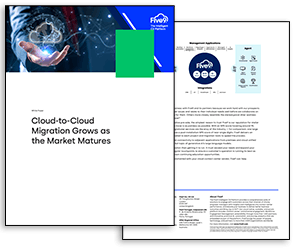Sunny Dhami of RingCentral promotes the use of cloud technology within the contact centre space.
Digital transformation is one of the most common buzzwords in the IT and communication industries.
The question is, what does it mean for your business?
Everyone seems to be talking about digital transformation, but not enough companies are explaining why it’s essential for brands to evolve.
In some circles, the need for “DX” initiatives are ignored completely as organizations believe that they’re reserved for companies with deeper investments into disruptive tech like AI, IoT, and Big Data.
However, the truth is that a digital transformation is something that every business needs, no matter how big or small it might be.
It’s time to uncover the truth about digital transformation.
What Is Digital Transformation?
At its core, digital transformation is about adapting your business operations, processes, models, methodologies, and competencies to take full advantage of the digital landscape.
DX is an opportunity to modify your existing ideas and create new pathways to the future, using technology that’s built to unlock new proficiencies and opportunities in your organization.
With the right strategy, companies can improve their business performance, drive better revenues, increase marketplace competition, and even improve customer experiences.
The concept of digital transformation is everywhere – not just in huge enterprises. Countries and their governments are beginning to discover the potential of digital technology to transform the way that we live and interact.
For instance, Japan is currently working on their “Society 5.0” initiative, to make social environment and public places more innovative than ever before.
We’ve seen the impact that digital transformation can have in the form of new and disruptive companies that have used the digital world to change their operations from the ground up.
At a smaller scale, digital transformation can refer to the steps that businesses take to make their operations more efficient by replacing antiquated and legacy systems with new and improved models.
It wasn’t so long ago that we were still keeping records on paper and sending information over fax. Today, we can store endless pieces of data in the cloud, communicate with co-workers in real time through instant messaging applications, and collaborate through video.
Just as it’s easier to find and share information when documents are digitized and available online, it’s also possible to simplify various other business processes through a digital lens.
Time-consuming and expensive travel can be replaced by face-to-face interactions via video. Overwhelming data analytics and engineering can be handled by advanced artificial intelligence tools and machine learning.
Just look at Uber’s ability to hijack the transportation sector or Netflix’s impact on the way that we consume entertainment. However, any business can achieve this kind of disruptive evolution – you just need to find the right digital transformation strategy.
The Cloud and Digital Transformation
There’s no one-size-fits-all answer. Some DX strategies are sophisticated and industry-changing, others are small but significant, transforming the way that a particular team or group works each day.
For the most part, the theory behind digital transformation remains the same for all organizations. Rather than just using new technology to replicate an existing service in digital format, businesses need to look for ways to transform their operations and services to something inherently better.
Fortunately, the cloud can help.
One of the biggest challenges that companies face in today’s internet-first environment is that there are more people, processes, and data to handle than ever before.
Companies are increasingly dedicating more staff and IT resources to the continuous management and creation of systems of engagement, action, and insight, generally with the hope of improving both business operations and customer experience.
In a legacy environment, keeping up with this constant flow of data and new technology would be practically impossible. It would require continuous investment and huge costs, which is why, in the past, only the largest corporations have been able to stay ahead of the curve.
However, in today’s age of customer experience, even smaller brands can’t afford to fall behind.
That’s where the cloud comes in. By embracing cloud-based infrastructure, your company can modernize the IT environment and focus on finding new ways to serve your employees, business goals, and customers in new digital formats.
Although many businesses assume that the purpose of digital transformation is to explore things like AI and IoT, the truth is that it starts at a much simpler level, with a transition into the cloud.
Cloud-based systems are the key to delivering flexible, on-demand access to the resources that underpin the new digital business solutions you need.
It’s how you ensure that you’re ready to scale your infrastructure according to the changing demands of modern business priorities, while keeping the risk of wasted resources and investments to a minimum.
With cloud solutions provided by a vendor like RingCentral, businesses can unlock incredible opportunities in a range of different environments. For instance, you can:
Access More Information From Employees and Customers
Use the cloud to unlock trapped data in your contact centre, gathering useful insights from the interactions that your employees have with each other and customers every day.
Transform Data into Useful Insights
Because the cloud gives you more bandwidth to gather and store valuable information, it also means that you can discover useful insights from that data.
Many cloud-based solutions like cloud communication environments come with analytical services that give businesses the resources they need to make the most of a growing data environment.
Enhance Collaboration
With a cloud-based strategy, businesses can connect all aspects of their communication and collaboration network in a single unified environment.
This ensures that you can access more scalable communications that suit the specific needs of your company, driving better productivity and employee satisfaction.
Reduce Costs
The cloud offers incredible flexibility. Rather than having to upgrade your entire system every time a new and disruptive technology appears; you’ll be able to access new functionality at the click of a button.
Expensive hardware investments are kept to a minimum, while businesses access more scalability than ever.
From Telephony to Next-Gen Cloud Communications
In the past, implementing new communication solutions was a time-consuming and expensive process for many companies.
However, the age of cloud and digital transformation mean that it’s now easier than ever for businesses to make sure that they’re empowering their teams with the communication strategies that they need.
Since communication is at the heart of both your employee and customer experience strategies, it’s not something that any business can afford to take lightly.
An outdated communication system could mean that your team members struggle to work efficiently and drive effective outcomes for your business.
Similarly, a poor communication strategy in your contact centre makes it harder to deliver the kind of customer engagement experiences that today’s clients expect.
With cloud communications strategies, businesses have the opportunity to build on top of their existing legacy technology or replace their systems entirely with something more effective.
For instance, if you notice that you’re attracting a lot of younger customers from the millennial and Gen Z demographics, you may decide that the best way to continue connecting with them is to offer instant messaging and chatbots as a form of additional customer service.
The cloud allows you to access this functionality through at the click of a button, with no need for any added hardware. Within that chat service, you can even offer the option to accelerate a conversation to a voice or video call using VoIP.
The cloud offers a level of freedom that businesses have never been able to access before.
Rather than installing and provisioning expensive new PSTN and network switches within an organization whenever you need to upgrade your communications strategy, you can maintain the same hardware and update your software to deliver greater functionality.
On the other hand, some businesses are choosing to remove the reliance on hardware entirely, by replacing desk phones with softphones and digital apps instead.
The cloud also means that companies can scale their communications strategies up or down according to the changing needs of the workplace.
For instance, if you have seasonal changes in demand in your business that require you to hire additional members of staff during specific parts of the year, you can add new numbers and call centre functionality for those periods and pay for only what you use.
Forward-thinking businesses and IT leaders are already beginning to discover the benefits of cloud communications to help them compete in today’s digital environment.
With the cloud, businesses of any size can stay at the forefront of technological change and meet consumer demands. All the while, you’re mitigating the impact of rising resource commitments, complexity, and costs often associated with legacy systems.
Unified Communications for Digital Transformation
One of the business areas that can access some of the biggest benefits of digital transformation is communication. After all, communication is at the heart of any company’s operations.
If your teams can’t communicate effectively, and your business can’t reach your target customers, then your entire enterprise crumbles.
For a long time, businesses relied exclusively on telephony for communications. The world was powered by voice alone, which meant that interactions were somewhat limited, and call centres were often overwhelmed by endless volumes of calls.
Today, the power of voice is still significant. However, there’s more to communication than telephony alone.
We’ve entered the age of unified communications, where voice, video, instant messaging, presence, web conferencing, and other technologies come together to create a more comprehensive experience.
In an age where customers demand faster, more diverse ways to connect with the brands that they love, unified communications is the key to better engagement.
So, What is Unified Communications?
Unified communications (UC) is one of the underlying facets of cloud communications.
UC brings together a variety of enterprise applications found in mobile and desktop devices over the years and brings them together into a single-pane-of-glass, intended to enhance productivity and efficiency in the digital world.
Powered by the freedom and flexibility of the cloud, unified communication is often at the heart of most digital transformation initiatives.
It gives businesses new ways to communicate while ensuring that every component in a multichannel strategy is connected in a way that’s simple, efficient, and cost-effective for the company.
When implemented correctly, a UC solution can provide consistent and convenient experiences to customers and employees alike, regardless of what device or mode of communication is used.
For companies in need of true flexibility, vendors like RingCentral also offer new ways of providing cloud-based unified communication solutions.
For instance, UCaaS, or Unified Communications as a Service, ensures that brands can access an all-in-one solution for messaging, voice, video, collaboration, and more through a single vendor.
Because the system is offered “as a service”, there’s no need to worry about extensive back-end management and extra complexity for your IT team either.
How Cloud Communications Improve the User Experience
In all facets of the business world, digital transformation is affecting the way that work gets done. The age of DX forces businesses to take a step back and examine everything that they do, from using internal systems to managing customer interactions both in-person and online.
We’ve already looked at how cloud communications can transform the employee and business experience by empowering team members and enhancing everyday processes. However, it’s also worth examining how the cloud and digital transformation can affect customer experience too.
Now that customer experience is the key to success in any environment, the demand for better CX is often one of the key driving factors behind any digital transformation strategy. Here’s how cloud communication translates into more meaningful moments between brands and customers.
Strengthening Customer Connections via Omnichannel Communications
The cloud opens a business up to doing business through multiple channels – not just voice. With a cloud-based unified communications as a service solution, you can reach out to your customers on the channel that suits them.
This could include instant messaging and text, or video conferencing, email, web conferencing, or anything else you can think of. More importantly, these real-time conversations can happen on any device.
A customer could start their request for service in the contact centre by sending a message to a chatbot on a business website. If they can’t find what they need with the chatbot, they can ask to be passed onto a service agent, who can use screen-sharing tools to help talk the customer through their problem.
The same agent can then accelerate the call to a video or voice conversation, all while using the same unified environment on the back-end. This leads to quicker, more seamless interactions for customers, using technology that they feel comfortable with.
Faster Resolutions to Problems
In a cloud communications environment, businesses can combine their contact centre technology with a range of other technologies to help agents resolve issues faster.
For instance, you could integrate your RingCentral Office environment with your CRM data, so that agents in your contact centre can collect useful information about a customer when answering their questions.
If you know which issues your client has had in the past, and which products they’ve purchased, you’ll be able to deliver a more personalized and relevant quality of service.
Businesses can also pull UCaaS and CCaaS systems together to make sure that team members have the option to collaborate with specialists and experts on the back end.
If an agent is having a hard time resolving a customer issue, they can check presence data and message someone on their team in real time for assistance. This means that there’s a greater chance of a first-time resolution for the customer.
Opportunities for Continuous Growth
With access to the flexibility and scalability of the cloud, companies can also safely store information about conversations with customers, while remaining compliant with regulations like GDPR.
Feeding this information into analytics systems will allow businesses to learn more about what their customers need, to improve future interactions.
Many companies today are experimenting with things like predictive analytics, intelligent routing, and more, to boost their chances of solving customer problems quickly and effectively.
By gathering the correct data from your interactions with customers, you could even create chatbots and virtual agents that assist your customer service representatives in offering around-the-clock care to customers.
Now that today’s clients expect 24/7 service from brands, chatbots, artificial intelligence, and other disruptive technologies are becoming a more compelling option for businesses of all sizes.
However, before any company can tap into the benefits of these opportunities, they need to start with the right data, housed in the right environment: the cloud.
Cloud communications open the door to future innovations and opportunities that will allow businesses to truly transform their customer engagement initiatives.
Making Digital Transformation Work for Your Business
Digital transformation is no longer an option for today’s businesses.
In a world that’s continually evolving, with new demands from customers, new technology, and ever-increasing expectations, all organizations need to adapt to thrive.
If you want to remain successful and competitive in the current landscape, then you need to be willing to replace the outdated systems that could be tethering you to the past.
Legacy solutions that prevent you from evolving and serving your customers could be the anchors that are holding your business down. Embracing the future with the cloud and digital transformation will mean that you can not only keep pace with ongoing innovation but also ensure that your business has what it takes to survive in the future.
While there’s no one-size-fits-all strategy for digital transformation, there are a few essential pillars that all enterprises need to consider when they’re planning their future.
Here are the four pillars of digital transformation you need to keep in mind:
1. Simplicity
In an age of IoT, AI, and countless other intricate pieces of technology, it’s easy to get carried away attempting to embrace the newest and shiniest thing.
However, simplicity is at the heart of adoption. For digital transformation to be truly successful, you need to convince your entire team to transition into a new way of working and operating.
Change is never an easy concept – even in today’s fast-moving world. The simpler it is for your team members to take advantage of your new tools, the more likely it is that they’ll move into the future with as little friction as possible.
Find yourself a digital transformation solution that puts simplicity first. A Unified Communication as a Service solution can help here. Not only does it place all of the tools your teams need into the same space, but it makes your communication stack easier to manage too.
2. Agility
Agility is a buzzword that goes hand-in-hand with the age of digital transformation. The marketplace is evolving at a rapid pace, and this means that companies need to be willing to evolve with it, often at a rapid pace.
To stay ahead of the curve, you can’t just implement the technology that’s cutting edge right now, you also need to make sure that you’re ready for the upgrades to come.
The cloud gives businesses the agility they need to keep updating and enhancing their environment to suit the changing demands of their business, employees, and customers. Through cloud communications and as-a-service offerings, you can ensure that you’re always ready to transform, whenever you need to.
3. Enablement
One of the major driving forces behind any digital transformation strategy is customer experience. The right solution will ensure that you can give your customers the power to connect with you, however they choose, in an environment that they feel comfortable in.
However, a genuinely successful DX initiative isn’t just about customer enablement, it’s about employee empowerment too.
With 50% of UK employees set to work remotely from 2020, make sure that your digital transformation campaign allows you to serve and support your team members wherever they might be. Use the cloud and unified communications to ensure that anyone can access the right tools for better business processes, wherever they are.
4. Security
Security will always be essential to any business initiative. Today, consumers and companies are more concerned about security and privacy than ever before, particularly in a time with things like GDPR affecting the way that we manage data.
Before you can make any significant changes to your business operations, it’s essential to make sure that you keep security in mind.
How will you protect employees on the go by ensuring that their cloud environment remains secure, wherever they choose to log into it? What will you do to stay compliant with GDPR, and ensure that your customers feel safe when they call your contact centre?
Where will you store the data you collect for analytics, and how will you decide when to purge your systems?
Embracing Digital Business Transformation

Sunny Dhami
Digital transformation is more than just a buzzword, it’s a strategy intended to transform the way that your business works. By adapting your culture, processes, and customer experiences to meet changing company and market requirements, you can ensure that you stay ahead of the competition and maintain your position in the marketplace.
Author: RingCentral
Published On: 23rd Sep 2019 - Last modified: 26th Feb 2025
Read more about - Expert Insights, Cloud, Digital Experience, RingCentral, Unified Communications

















